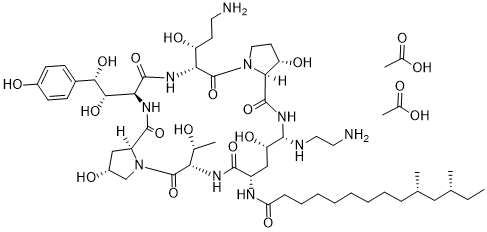| Cas No.: | 179463-17-3 |
| Chemical Name: | Caspofungin acetate |
| Synonyms: | Cancidas;Caspofungin acetate;(3S,6S,9S,11R,15S,18S,20R,21S,24S,25S)-21-(2-Aminoethylamino)-3-[3-amino-1(R)-hydroxypropyl]-6-[1(S),2(S)-dihydroxy-2-(4-hydroxyphenyl)ethyl]-18-(10,12-dimethyltetradecanamido)-11,20,25-trihydroxy-15-[1(R)-hydroxyethyl]-1,4,7,13,16,22-hexaazatricyclo[22.3.0.0(9,13)]heptacosane-2,5,8,14,17,23-hexaone diacetate;Caspofungin;Caspofungin (acetate);Gaspofungin;Caspofungin Diacetate;L 743872;L-743,872;L743873;LY231514 disodium;Mk0991;Pemetrexed Disodium;Casp ungin Acetate;Mk 0991;L-743872;L 743873;L 743,872 |
| SMILES: | CC[C@@H](C)C[C@@H](C)CCCCCCCCC(N[C@@H]1C(N[C@@H]([C@H](O)C)C(N2[C@](C[C@@H](O)C2)([H])C(N[C@@H]([C@H](O)[C@@H](O)C3=CC=C(O)C=C3)C(N[C@H]([C@H](O)CCN)C(N4[C@]([C@@H](O)CC4)([H])C(N[C@H](NCCN)[C@@H](O)C1)=O)=O)=O)=O)=O)=O)=O.CC(O)=O.CC(O)=O |
| Formula: | C56H96N10O19 |
| M.Wt: | 1213.42 |
| Purity: | >99% |
| Sotrage: | 2 years -20°C Powder, 2 weeks 4°C in DMSO, 6 months -80°C in DMSO |
| Description: | Caspofungin (Acetate) is an antifungal drug, and noncompetitively inhibits 1,3-β-d glucan synthase activity. |
| In Vivo: | Mice injected with caspofungin at vitreal concentrations from 0.41 to 4.1 μM do not have significant alterations in their ERG waveforms, and their retinas have no detectable morphologic changes or loss of cells. At the vitreal concentration of 41 μM, caspofungin reduces the amplitudes of the a-waves, b-waves, and scotopic threshold responses of the ERG and also produces a decrease in the number of cells in the ganglion cell layer[1]. Caspofungin (8 mg/kg) or amphotericin B at 1 mg/kg given i.p. once daily for 7 days beginning at 30 h after infection resulted in 100% survival through day 28 relative to vehicle control treatment, which results in 100% mortality by day 11 after infectious challenge. Caspofungin reduces recovery of viable Candida from kidney and brain tissues compared to vehicle control treatment on day 5, when control burden peaked. Caspofungin-treated mice dosed with 2 mg/kg or greater have significantly lower brain burden than amphotericin-B-treated mice at day 5. Amphotericin B and caspofungin treatment reduce kidney fungal burden by 1.7 log CFU/g and 2.46 to 3.64 log CFU/g, respectively[2]. |
| Animal Administration: | Antifungal therapy is initiated at 30 h after infectious challenge and is given by intraperitoneal (i.p.) injection once daily for 7 days. Mice are treated with caspofungin at 1, 2, 4, or 8 mg/kg/day, amphotericin B at 1 mg/kg/day, or vehicle control (sterile distilled water). Efficacy in this model is assessed in 3 ways: by monitoring survival in a group of 10 animals in each treatment group, by monitoring Candida burden in kidney and brain tissues in a second set of treated animals, and by histologically evaluating the kidneys and brains in a third set of treated animals. Mice are euthanized by CO2 inhalation, and tissues for both culture and histology are sampled at 30 h (vehicle-treated control only) and at days 5 (24 h after 4th dose), 8 (24 h after last dose), 14, 21 (caspofungin-treated only), and 28 after challenge. |
| References: | [1]. Mojumder DK, et al. Evaluating retinal toxicity of intravitreal caspofungin in the mouse eye. Invest Ophthalmol Vis Sci. 2010 Nov;51(11):5796-803. [2]. Flattery, Amy M. et al. Efficacy of caspofungin in a juvenile mouse model of central nervous system candidiasis. Antimicrobial Agents and Chemotherapy (2011), 55(7), 3491-3497. |

 DC Chemicals' products qualify for U.S. tariff exemptions. We guarantee no price increases due to customs duties and maintain stable supply, continuing to deliver reliable research solutions to our American clients.
DC Chemicals' products qualify for U.S. tariff exemptions. We guarantee no price increases due to customs duties and maintain stable supply, continuing to deliver reliable research solutions to our American clients.





















